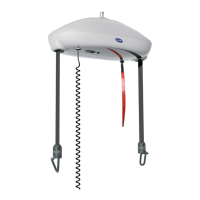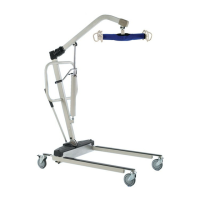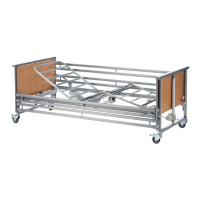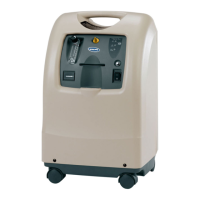3.3 Safety guidelines
Emergency stop
If the hoist straps´ moves unintentionally upwards or downwards, pull the »emergency stop« chord.
When the emergency stop is activated, the hoist will not operate. If the emergency stop button is pushed up, the
hoist will be ready for use again.
Emergency lowering
The emergency lowering feature can be used in order to lower a client to the transfer surface if the hoist has
become inoperable. Emergency lowering is operated by continuously pulling the cord.
When the emergency lowering function is activated, all end stops and security functions are
deactivated. It is thereby possible to wind up the lifting straps back up, when activating the
emergency lowering for prolonged periods.
Strap securing/pinch protection
If the lifting straps are guided incorrectly in and out of the hoist, i.e. if the straps has become twisted, the hoist will
automatically turn off.
Note: When attaching the sling to the hooks, and the straps are twisted, the straps will rotate and stretch out,
thus ensuring trouble-free operation.
The pinch protection feature automatically turns off the hoist, if a client unintentionally traps his/her hand in the
lifting strap during a lift. The hoist will stop immediately when the hand makes contact with the strap inlet.
If Robin
TM
is loaded with a weight of more than 200 kg, the hoist will automatically turn off to safeguard against
overloading.
Electromagnetic interference between the hoist and other electrical products can occur.
To reduce or eliminate such electromagnetic interference, increase the distance between the
hoist and the products or switch off the products!
All installations must comply with the national rules and standards. Use only approved installation
components. At every point of suspension, the roof/ceiling structure must be able to absorb a load
of at least 300 kg.
3.4 Charging
A sound indicator and the flashing indicator light signals when the hoist needs to be charged. The hoist must be
moved along the rail system and parked nearby the wall mounted charger. Attach the hand control to the charger
unit. LED on the charger indicates that charging is taking place. We recommend parking the hoist in the charging
position when not in use.
LED indication Function Function duration
Yellow Battery not connected -
Yellow Initializing and analysis of battery 12 - 14 seconds
Red Fast charge 5 min - 2 hours
Green Trickle charge -
Alternating red and green Fault condition (battery defect)
-
There will still be sufficient power to lower the user from the time when the hoist indicates that charging is
needed.
If the battery should become totally discharged while a transfer is in progress, an external battery may be tempo-
rarily connected to the hoist. See the section »Battery«.
NB! It is recommended to interrupt the charging and pull the emergency stop, when the lifter has not been used
for more than 4-6 weeks.
13

